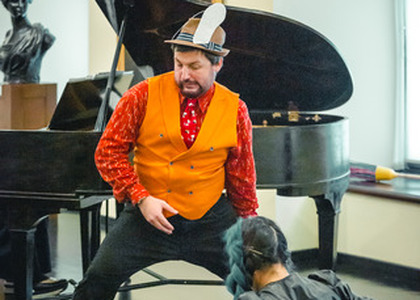> [Archived] Events

Among sounds, pranks, clocks and dreams
On November 7th, the final show of the educational series proposed by the project Mihail Jora - The time which makes us approach eachother
In a current atomized context, with a multitude of stimuli developed in extremely different directions, the friendship of children with classical music, especially with that of the twentieth century sung on piano solo, may not seem, at first glance, the most safe solution. It is clear that traditional approaches can no longer compete with the contemporary challenges with which children are constantly bombarded and that the solution is more about creative proposals, which go beyond the strictly musical sphere.
Such a happy example is the show "Photos and Pranks", from the project «Mihail Jora - The time which makes us approach eachother» , imagined and developed by the Union of Music Critics, Editors and Producers in Romania, by Monica Isăcescu and Ștefan Costache. Between October 9th and November 7th, six events took place in which the music of the three suites "Photos and Pranks" dedicated to children by Mihail Jora was fully presented, the music being wrapped in a playful, inspired and imaginative story. Indeed, the script created by Celina Rotar-Petrescu cleverly and meaningfully pigments the descriptive pages, with so many facets of character signed by Jora and interpreted nuanced and empathetic by Adriana Toacsen, in the role of the pianist Ant. Because outside the piano, with its own pictures and pranks, the story brings to the fore three characters: The Clock Rabbit, played by Ionel Barac, the witch Zelda, played by Adela Mihai, both respected actors and the skillful Ant on the keyboard.
I came to the last event in the series, which took place at the Museum of Art Collections in Bucharest, curious to observe the children's reaction to this show in which the pranks flow from the piano to the characters and back to the keys in black and white, in an endless stream , which lasts for about an hour. After all, children are the finest, most sincere and most receptive barometer of an artistic act dedicated to them. Children can sometimes be a much more difficult audience than adults, who can often be saved by complacency. Well, from the first lines, I realized that what was originally a music and theater show turned into an interactive experience, in which the Rabbit, internalized and hesitant, answered questions, was advised, picked up cars. who accidentally landed in front of him on the floor, while Zelda launched into confessions, and then, when they were in danger of being revealed, uttered firm threats against those who would have revealed her secret and thus could be transformed into… pumpkins. Adela Mihai and IonelBarac are convincing through their persuasion and adaptability, behind the stage performance feeling the passion and pleasure to play and to play. I didn't realize when an hour had passed, and the children even less, captivated by the story, by the movement, by the characters visible with the "eye of the mind". And I realized that Celina Rotar Petrescu intended and managed through this delicious scenario to introduce us to a space of imagination and surrealism, with which, moreover, children's minds operate naturally and can enrich, color and gives meaning to everyday life. And Jora's music, with its refinement, plasticity, its traditional-Romanian flavor, but also its fine allusions to established European musical genres, with all its universal and so personal character, perfectly completed the story. A successful and ingenious experience, with the help of which the children penetrated naturally and naturally into the sonic imaginary of Mihail Jora's music, a music that, here, you can sing, but you can also dance on it, run or accompany it with gestures of pantomime. And I thought how useful it would be for this kind of shows to exist in the ordinary seasons of the Romanian cultural life! The smiles on the children's faces, but also on those of the adults, from the end, undoubtedly confirmed my perception.
"How many dreams per second do you get to the Vandal Planet on the Astral Highway?" - one wonders, at a certain moment, the Clock Rabbit; an interrogation that reminds us not to forget that there is this important parallel between real and imaginary and that dreams are just as important for achieving the goal. So let's not forget to dream. Especially with your eyes open.
Translated by Alma Teodora Miron,
University of Bucharest, Faculty of Foreign Languages and Literatures, MTTLC, year II
Corrected by Silvia Petrescu














